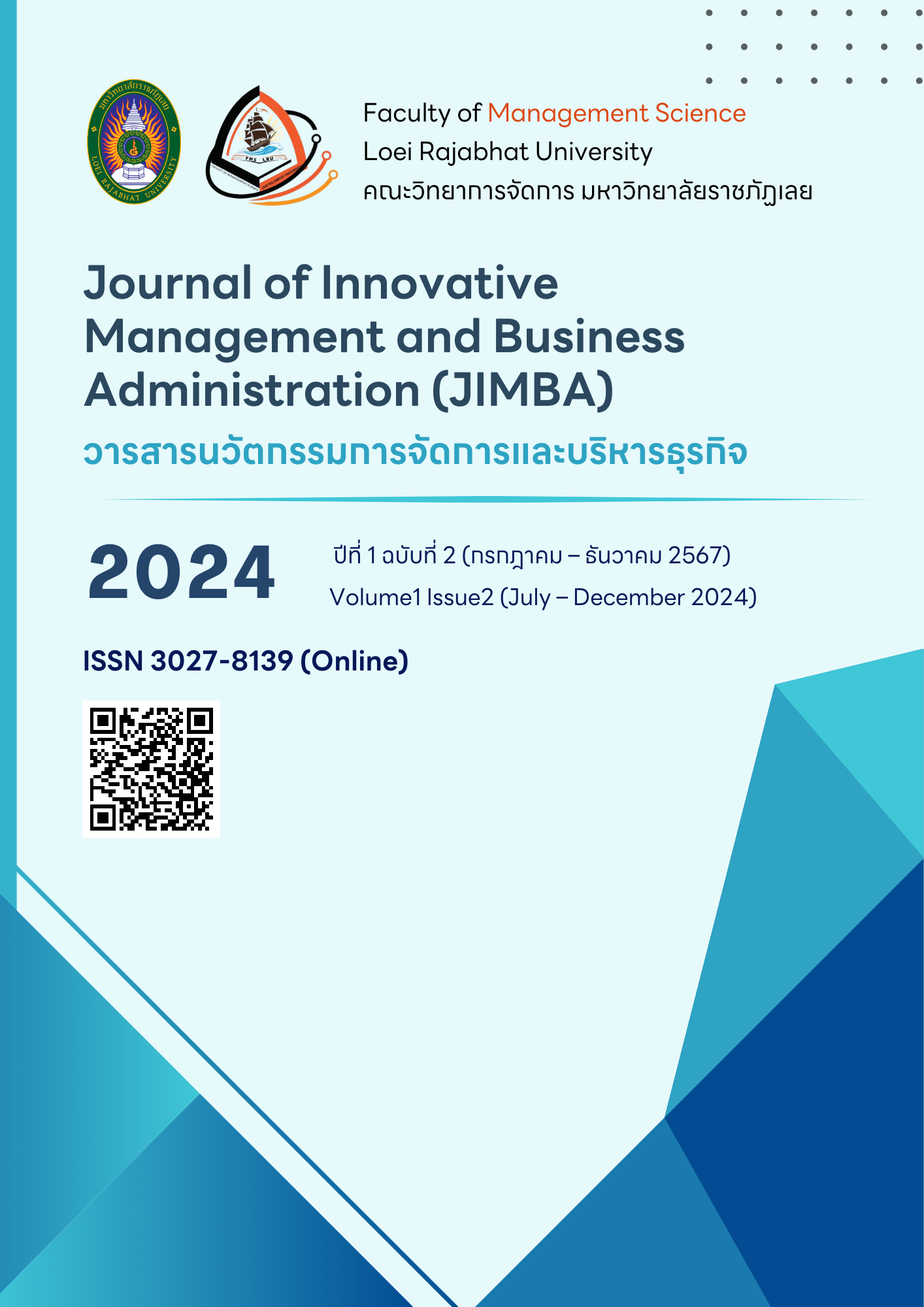Decision-Making in Using Food Delivery Services Among Generation Y in the Prachatipat Area, Pathum Thani Province
Main Article Content
Abstract
This research aims to study: 1) the decision-making for selecting food delivery services for the generation Y demographic within Prachathipat district, Pathum Thani province. And 2) the comparison of the decision-making process for selecting food delivery services for the generation Y demographic users based in Prachathipat district, Pathum Thani province classified by demographic
characteristics including gender, age, education level, and average monthly income. This research is quantitative research. The sample group is the generation Y demographic food delivery app users in Prachathipat district Pathum Thani province. Moreover, the number of users was unknown. Therefore, 400 people were selected by convenience random sampling. Data was collected using a questionnaire and analyzed using descriptive statistics, frequency, percentage, mean, standard deviation, and inferential statistics, including comparisons by F-test. Pairwise average comparison utilizes SCHEFFE and One-Way ANOVA statistics. The study found that most respondents had a high score in all aspects of the decision-making process for using the food delivery services, including awareness of need, purchasing decision, researching, post-purchase behavior and evaluating the available alternatives. Additionally, the differences in demographic characteristics including gender, age, education level, and average monthly income are the reasons why generation Y make different decisions when using food delivery services, with a significant statistical difference of 0.05.
Article Details

This work is licensed under a Creative Commons Attribution-NonCommercial-NoDerivatives 4.0 International License.
บทความนี้ได้รับการตีพิมพ์เป็นลิขสิทธิ์ของมหาวิทยาลัยราชภัฏเลย
เนื้อหาและข้อมูลในบทความที่ตีพิมพ์ใน วารสารนวัตกรรมการจัดการและบริหารธุรกิจ มหาวิทยาลัยราชภัฏเลย ถือเป็นความคิดเห็นและความรับผิดชอบของผู้เขียนบทความโดยตรง กองบรรณาธิการวารสารไม่มีส่วนในความคิดเห็นและความรับผิดชอบใดที่เกี่ยวข้องกับบทความดังกล่าว
References
กรมการปกครอง กระทรวงมหาดไทย. (2566). ประกาศกรมการปกครองเรื่องแจ้งข้อมูลทางการปกครอง. สืบค้น 13 มกราคม 2566, จาก https://www.dopa.go.th/news/cate1/view6988.
กัญจนพร ลิ้มผ่องใส. (2564). ทัศนคติ การรับรู้ประโยชน์ การรับรู้ความง่ายต่อการใช้งาน และคุณภาพการให้บริการที่มีอิทธิพลต่อการตัดสินใจใช้บริการบริษัทขนส่งอาหารออนไลน์ของร้านอาหารในกรุงเทพมหานครและปริมณฑล. (บริหารธุรกิจมหาบัณฑิต). มหาวิทยาลัยรามคำแหง, กรุงเทพฯ.
กัญจ์นวีร์ ณ ป้อมเพ็ชร. (2564). ปัจจัยที่มีอิทธิพลต่อการตัดสินใจซื้อเบเกอรี่ผ่านแอปพลิเคชันสั่งอาหารออนไลน์ของผู้บริโภคเจเนอเรชั่นวายในกรุงเทพมหานคร. (ปริญญาการจัดการมหาบัณฑิต). มหาวิทยาลัยมหิดล, กรุงเทพฯ.
กานติมา ธรรมศิริ. (2564). การศึกษาความเป็นไปได้ในการพัฒนาธุรกิจคลาวด์คิทเช่นในเขตพื้นที่จังหวัดพิษณุโลก. (ปริญญาการจัดการมหาบัณฑิต). มหาวิทยาลัยมหิดล, กรุงเทพฯ.
กิตติอำพล สุดประเสริฐ พิชชรัตน์ รื่นพจน์ และวัชระพล วงศ์จันทร์. (2564). ปัจจัยส่วนประสมทางการตลาดที่มีอิทธิพลต่อพฤติกรรมของผู้บริโภคในการเลือกใช้แอปพลิเคชันไลน์แมนเพื่อบริการรับส่งอาหาร ในเขตอำเภอพุทธมณฑล จังหวัดนครปฐม. วารสารวิทยสารสนเทศและเทคโนโลยี, 2(2), 51 – 60.
จักรภพ ศิริทัพ. (2565). ปัจจัยส่วนประสมทางการตลาดและความพึงพอใจของผู้บริโภคที่ส่งผลต่อการตัดสินใจใช้แอปพลิเคชั่น Grab ฟู้ดเดลิเวอรี่ ของผู้บริโภคในกรุงเทพมหานครและปริมณฑล. (วิทยานิพนธ์บริหารธุรกิจมหาบัณฑิต). มหาวิทยาลัยเทคโนโลยีราชมงคลธัญบุรี, กรุงเทพฯ.
ชัยนันท์ ไชยเสน. (2564). ทำไมธุรกิจร้านอาหารไม่ประสบความสำเร็จและแนวทางการพัฒนาสู่ความเป็นเลิศ. วารสารการบริการและการท่องเที่ยวไทย, 16(2), 85 – 96.
ชุติมา นัยนิตย์. (2564). แรงจูงใจด้านความเพลิดเพลินในการเลือกสินค้าและบริการในการสั่งอาหารแบบเดลิเวอรี่ผ่านโมบายแอปพลิเคชันกลุ่ม Gen Y. (ปริญญาการจัดการมหาบัณฑิต). มหาวิทยาลัยมหิดล, กรุงเทพฯ.
ณัฐกฤษ เชาว์ชาญกิจ. (2564). การตัดสินใจเลือกใช้บริการแอปพลิเคชันสั่งอาหารออนไลน์ของผู้บริโภคในเขตกรุงเทพมหานครและปริมณฑล. (บริหารธุรกิจมหาบัณฑิต). มหาวิทยาลัยกรุงเทพ, กรุงเทพฯ.
ดวงใจ คงคาหลวง พงษ์สันติ์ ตันหยง และวัลลภา วิชะยะวงศ์. (2566). ตัวแบบปัจจัยเชิงสาเหตุที่มีอิทธิพลต่อความภักดีของผู้บริโภคอาหารออนไลน์. วารสารสหวิทยาการมนุษยศาสตร์และสังคมศาสตร์, 6(1), 308-326.
ธานินทร์ ศิลป์จารุ. (2563). การวิจัยและวิเคราะห์ข้อมูลทางสถิติด้วย SPSS และ AMOS (พิมพ์ครั้งที่ 5). กรุงเทพฯ: บริษัท เอส. อาร์.
นพพงศ์ เกิดเงิน สุทธาทิพย์ กำธรพิพัฒนกุล และนรินทร สมทอง. (2564). ปัจจัยการยอมรับนวัตกรรมที่ส่งผลต่อความตั้งใจในการสั่งซื้ออาหารแบบออนไลน์เดลิเวอรีของผู้ใช้บริการในประเทศไทย. วารสารบริหารธุรกิจ, 3(2), 1 – 19.
ศิริวรรณ เสรีรัตน์ และคณะ. (2560). การบริหารการตลาดยุคใหม่: (Marketing Management)ฉบับปรับปรุงใหม่. กรุงเทพฯ: Diamond In Business World.
สภาองค์กรของผู้บริโภค. (2566). ปัญหาของผู้บริโภคจากการใช้บริการสั่งอาหาร Food Delivery. สืบค้น 16 สิงหาคม 2566, จาก https://www.tcc.or.th/appeal.
อุษา โบสถ์ทอง และคณะ. (2566). ปัจจัยส่วนประสมทางการตลาดบริการที่ส่งผลต่อการตัดสินใจใช้แอปพลิเคชัน 7-Delivery ของผู้ใช้บริการในอำเภอเมือง จังหวัดลำปาง. วารสารการจัดการและการพัฒนา, 10(1), 185 – 204.
Anbumathi, R., Dorai, S., & Palaniappan, U. (2023). Evaluating the role of technology and non-technology factors influencing brand love in Online Food Delivery services. Journal of Retailing and Consumer Services, 71(1), 103181.
Bryman, A., & Bell, E. (2022). Business research methods (6th ed.). Oxford, UK: Oxford University Press.
Cronbach, L. J. (2003). Essential of psychology testing. New York: Harper.
Eberl, J. M., Huber, R. A., Mede, N. G., & Greussing, E. (2023). Populist attitudes towards politics and science: how do they differ?. Political Research Exchange, 5(1), 2159847.
Glimcher, P. W., & Tymula, A. A. (2023). Expected subjective value theory (ESVT): A representation of decision under risk and certainty. Journal of Economic Behavior & Organization, 207(1), 110-128.
Krejcie, R. V., & Morgan, D. W. (1970). Determining sample size for research activities. Educational and Psychological Measurement, 30(3), 607-610.
Petrontino, A., Frem, M., Fucilli, V., Labbate, A., Tria, E., & Bozzo, F. (2023). Ready-to-eat innovative legumes snack: The influence of nutritional ingredients and labelling claims in italian consumers’ choice and willingness-to-pay. Nutrients, 15(7), 1799.
Smith, J. (2022). Strategic marketing factors and decision-making process: A guideline for evaluation. New York, NY: Marketing Press.
Solomon, M. R. (2023). Consumer behavior: Buying, having, and being (14th ed.). Hoboken, NJ: Pearson.
Steele, E. M., O’Connor, L. E., Juul, F., Khandpur, N., Baraldi, L. G., Monteiro, C. A., & Herrick, K. A. (2023). Identifying and estimating ultraprocessed food intake in the US NHANES according to the Nova classification system of food processing. The Journal of Nutrition, 153(1), 225-241.
Yeo, T. E. D., & Chu, T. H. (2024). Adaptive self-reflection as a social media self-effect: insights from computational text analyses of self-disclosures of unreported Sexual Victimization in a Hashtag Campaign. Social Science Computer Review, 08944393241252640.


